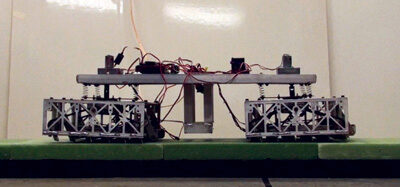
The venomous sidewinder rattlesnake has always been able to kill you - but now could it help save you, too.
Biologically inspired robotics has developed into a major focus at the Institute, with multiple labs looking to the animal kingdom for inspiration. One challenge that has long vexed researchers is the ability to traverse across sand. It’s a tricky prospect, as sandy surfaces can take on the properties of a solid, a liquid and even a gas. But while robots struggle with the surface, various animals are able to move across sand, including lizards, sea turtles and snakes. Now Tech roboticists are mining the creatures’ behavior for their evolutionarily perfected secrets.
A robotics team led by Dan Goldman, an assistant professor in the School of Physics, and David Hu, an assistant professor of mechanical engineering, began performing comparative studies on how sea turtles and sandfish (which essentially swim on land) move over sand. Then they turned to snakes.
One snake-based robot that came out of the lab—known as Scalybot (pictured below) —was effective on many surfaces, but it always got stuck in sand. Many real snakes struggle with sand, too. They partnered with Joe Mendelson, curator of herpetology at Zoo Atlanta and an adjunct professor at Tech, to study a snake that’s at ease on sand: the sidewinder rattlesnake.

“They’re famous for their funky sideways locomotion through sand dunes,” Mendelson says.
Georgia Tech prohibits venomous snakes on campus, and Tech researchers themselves can’t handle poisonous animals. Mendelson’s position at Zoo Atlanta allowed him to collect sidewinders from Arizona and conduct the research at the zoo in “the world’s most expensive sandbox.” Tech’s researchers simply observed the results.
The team now has a firm understanding of how sidewinders handle sandy slopes, and they’re examining how the snakes navigate obstructions. While sidewinder-style robots have obvious uses—search-and-rescue missions, military operations, planetary exploration—research partners from Harvard University have suggested sending the robots into sand-filled tunnels in Egyptian ruins.
“A robot can’t go down a sand-choked tunnel underground—only a snake can do that,” Mendelson says. “So we need a sidewinding robot with a camera that can look around. Then [if something of value is down there] you can put in the effort to dig it out.”
The needs of robots extend far beyond traversing sand, and inspiration has come from some surprising places. Hu received a lot of attention last year for publishing a study of the “wet-dog shake”—when dogs shake wildly to dry themselves. The physics of the wet-dog shake are impressive—dogs can shake themselves 70 percent dry in just a fraction of a second. While the research might seem silly, it does have useful implications. Hu says the research could be used for improved drying technology or in robotics.
“In the future, self-cleaning and self-drying may arise as an important capability for cameras and other equipment subject to wet or dusty conditions,” he says.
Writer: Van Jensen
See full article on animal research at Georgia Tech in the Georgia Tech Alumni Magazine
